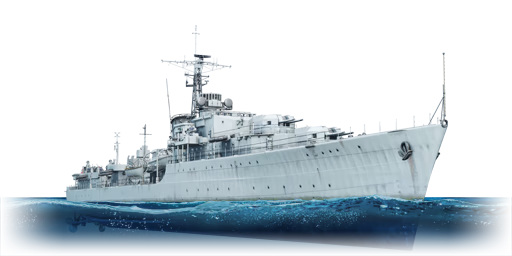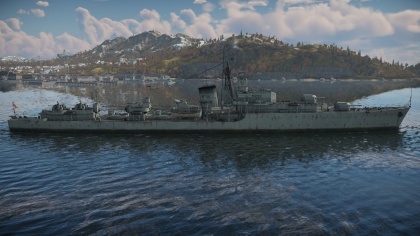Difference between revisions of "HMS Armada"
(Added image and basic info, Updated template to new design, Removed unnecessary code) |
(→History) |
||
| Line 53: | Line 53: | ||
== History == | == History == | ||
| − | ''Describe the history of the creation and combat usage of the ship in more detail than in the introduction. If the historical reference turns out to be too big, take it to a separate article, taking a link to an article about the vehicle and adding a block "/ History" (example: <nowiki>https://wiki.warthunder.com/(Vehicle-name)/History</nowiki>) and add a link to it here using the <code>main</code> template. Be sure to reference text and sources by using <code><nowiki><ref></nowiki></code>, as well as adding them at the end of the article.'' | + | <!--''Describe the history of the creation and combat usage of the ship in more detail than in the introduction. If the historical reference turns out to be too big, take it to a separate article, taking a link to an article about the vehicle and adding a block "/ History" (example: <nowiki>https://wiki.warthunder.com/(Vehicle-name)/History</nowiki>) and add a link to it here using the <code>main</code> template. Be sure to reference text and sources by using <code><nowiki><ref></nowiki></code>, as well as adding them at the end of the article.''--> |
| + | Realizing the heavy losses to air attacks and the inability of the then current destroyer designs to deal with aerial threats, the Royal Navy decided to act. In 1941, the first plans for what would become the replacement for the Tribal-class were drawn up. | ||
| + | |||
| + | Contrary to previous classes, the new destroyers would focus on powerful AA armament, featuring large calibre, high-angle dual purpose guns assisted by a number of smaller calibre AA cannons. The proposed design was accepted in autumn of 1941 under the name “Battle-class” with initial plans to build a total of 16 ships, forming two flotillas. The first order for 10 ships was issued in April 1942, with the second order for the remaining six ships following in August. | ||
| + | |||
| + | Despite the orders already being placed, further debate among high-ranking officials about the final design of the ship continued. As the initial ships were already under construction, changes to the existing design couldn’t be applied anymore. This led to several more subclasses being developed, but that’s a story for another time. | ||
| + | |||
| + | Although the first ships were launched by November 1943, delays in their completion were caused by late deliveries of critical fire control systems. In the end, only a handful of ships were completed by the end of WW2 and none of them saw any combat action. However, most of the ships of the Battle-class continued to serve well into the Cold War. | ||
| + | |||
| + | HMS Armada was one of these early ships of the class to be completed, but due to similar reasons, was only commissioned into service in July 1945. After several port visits throughout the UK, she was placed in reserve in 1947 only to rejoin active service in 1949 as part of the 3rd Destroyer Flotilla, operating in the Mediterranean. | ||
| + | |||
| + | During the mid 1950s, HMS Armada was involved in the Suez Crisis, but rejoined the Home Fleet shortly after. In 1960, HMS Armada was decommissioned and five years later, in 1965, taken apart for scrap. | ||
| + | |||
| + | ''- From [https://warthunder.com/en/news/5835-fleet-development-hms-armada-d14-keeping-the-birds-at-bay-en Devblog]'' | ||
== Media == | == Media == | ||
Revision as of 07:48, 8 March 2019
Contents
Description
The Battle-class, HMS Armada (D14), 1943 is a rank British destroyer
with a battle rating of (AB), (RB), and (SB). It was introduced in Update 1.83 "Masters of the Sea" as part of the British fleet closed beta test.
General info
Survivability and armour
Talk about the vehicle's armour. Note the most well-defended and most vulnerable zones, e.g. the ammo magazine. Evaluate the composition of components and assemblies responsible for movement and manoeuvrability. Evaluate the survivability of the primary and secondary armament separately. Don't forget to mention the size of the crew, which plays an important role in fleet mechanics. Tips for preserving survivability should be saved for the "Use in battle" section.
If necessary, use a graphic template to show the most well-protected or most vulnerable points in the armour.
Mobility
Write about the ship’s mobility. Evaluate its power and manoeuvrability, rudder rerouting speed, stopping speed at full tilt, with its maximum forward speed and reverse speed.
Armament
Primary armament
Provide information about the characteristics of the primary armament. Evaluate their efficacy in battle based on their reload speed, ballistics and the capacity of their shells. Add a link to the main article about the weapon: {{main|Weapon name (calibre)}}.
Broadly describe the ammunition available for the primary armament, and provide recommendations on how to use it and which ammunition to choose.
Secondary armament
Some ships are fitted with weapons of various calibers. Secondary armament is defined by the weapon chosen with the control Select secondary weapon. Evaluate the secondary armament and give advice on how to use them. Describe the ammunition available for the secondary armament. Provide recommendations on how to use them and which ammunition to choose. Remember that anti-air armament, even heavy caliber weapons, belong in the next section.
If there is no secondary armament, remove this section.
Anti-aircraft armament
An important part of the ship’s armament responsible for air raid defense. Anti-aircraft armament is defined by the weapon chosen with the control Select anti-aircraft weapons. Talk about the ship’s anti-air cannons and machine guns, the number of guns and their positions, their effective range, and about their overall effectiveness – including against surface targets.
If there is no anti-aircraft artillery, remove this section.
Torpedo armament
Many ships are armed with torpedo launchers, and for some vessels such as boats, torpedoes are an extremely important means of defeating an opponent. Evaluate the position of the torpedo launchers, discuss the ammunition available, firing specifics such as dead zones, features of the torpedoes themselves, etc.
If there is no torpedo armament, remove this section.
Special armament
Depth charges, mines, rocket launchers and missiles are also effective in skilled hands and can be an unexpected surprise for an opponent. Evaluate the ammunition of this type of armament and rate its performance in combat.
Usage in battles
Describe the technique of using this ship, the characteristics of her use in a team and tips on strategy. Abstain from writing an entire guide – don’t get try to provide a single point of view, but give the reader food for thought. Talk about the most dangerous opponents for this vehicle and provide recommendations on fighting them. If necessary, note the specifics of playing with this vehicle in various modes (AB, RB, SB).
Pros and cons
Summarize and briefly evaluate the vehicle in terms of its characteristics and combat effectiveness. Mark its pros and cons in the bulleted list. Try not to use more than 6 points for each of the characteristics. Avoid using categorical definitions such as "bad", "good" and the like - they have a substitution in the form of softer "inadequate", "effective".
Pros:
Cons:
History
Realizing the heavy losses to air attacks and the inability of the then current destroyer designs to deal with aerial threats, the Royal Navy decided to act. In 1941, the first plans for what would become the replacement for the Tribal-class were drawn up.
Contrary to previous classes, the new destroyers would focus on powerful AA armament, featuring large calibre, high-angle dual purpose guns assisted by a number of smaller calibre AA cannons. The proposed design was accepted in autumn of 1941 under the name “Battle-class” with initial plans to build a total of 16 ships, forming two flotillas. The first order for 10 ships was issued in April 1942, with the second order for the remaining six ships following in August.
Despite the orders already being placed, further debate among high-ranking officials about the final design of the ship continued. As the initial ships were already under construction, changes to the existing design couldn’t be applied anymore. This led to several more subclasses being developed, but that’s a story for another time.
Although the first ships were launched by November 1943, delays in their completion were caused by late deliveries of critical fire control systems. In the end, only a handful of ships were completed by the end of WW2 and none of them saw any combat action. However, most of the ships of the Battle-class continued to serve well into the Cold War.
HMS Armada was one of these early ships of the class to be completed, but due to similar reasons, was only commissioned into service in July 1945. After several port visits throughout the UK, she was placed in reserve in 1947 only to rejoin active service in 1949 as part of the 3rd Destroyer Flotilla, operating in the Mediterranean.
During the mid 1950s, HMS Armada was involved in the Suez Crisis, but rejoined the Home Fleet shortly after. In 1960, HMS Armada was decommissioned and five years later, in 1965, taken apart for scrap.
- From Devblog
Media
An excellent addition to the article will be video guides, as well as screenshots from the game and photos.
See also
Links to the articles on the War Thunder Wiki that you think will be useful for the reader, for example:
- reference to the series of the ship;
- links to approximate analogues of other nations and research trees.
External links
| Britain destroyers | |
|---|---|
| Town-class | HMS Churchill · HMS Montgomery |
| V-class | HMS Valhalla · HMS Vega · HMS Verdun |
| G-class | HMS Grafton · ORP Garland |
| Hunt-class | HMS Calpe · HMS Brissenden |
| Tribal-class | HMCS Haida · HMS Eskimo · HMS Mohawk |
| J-class | HMS Jervis |
| K-class | HMS Kelvin |
| N-class | HMAS Nepal |
| Battle-class | HMS Armada · HMS Cadiz · HMAS Tobruk |
| Daring-class | HMS Daring · HMS Diamond · HMS Diana |





